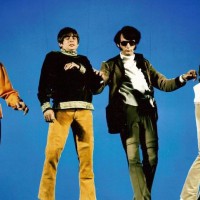In 1969, former Harvard Lampoon writers Doug Kenney, Robert Hoffman and Henry Beard, tailored a humor magazine for a counterculture crowd, got an investor and turned it into the newsstand magazine National Lampoon. The publication skewered popular culture, politicians and everyday people with a combination of jolting parody ads, nudity, crude short stories and underground comics. At the height of its popularity in 1974, National Lampoon sold close to a million issues a month.
The Lampoon subsequently spawned a play, a radio show, books and eventually a movie empire. The magazine’s original writers (and the actors on their radio and album projects) moved on to fame and fortune on Saturday Night Live and other TV shows and movies.
Director Douglas Tirola’s Drunk Stoned Brilliant Dead is an engaging and comprehensive look at the National Lampoon empire’s peak in the 1970s and early ‘80s. This 98-minute documentary covers a lot of ground, recounting office shenanigans and lucky breaks that turned an underground publication into a multi-media empire.
Drunk Stoned Brilliant Dead shares hundreds of wild (and sometimes politically incorrect) images from the publication’s halcyon days in the 1970s. One of the most infamous covers features a canine with a handgun pointed at its head and the headline “Buy this magazine or we’ll shoot this dog.” The audacious humor extended to parody ads: “If Ted Kennedy Drove a Volkswagen, He’d be President Today!” one such ad exclaims. The magazine endured an FBI investigation for a parody they wrote on Supreme Court Justice Thurgood Marshall. Some of the magazine’s more politically incorrect features (“Foreigners Around the World”, etc.) couldn’t be duplicated today without setting the Internet to outrage mode.
The fulm relies on vintage footage and interviews with the writers, artists and actors who made National Lampoon into a phenomenon – and a few of today’s writers influenced by them. The interviewees include Chevy Chase, John Landis, Judd Apatow, Billy Bob Thornton, P.J. O’Rourke, Tim Matheson, Kevin Bacon, Beverly D’Angelo, Ivan Reitman, Tony Hendra and Meat Loaf.
Members of Chicago’s Second City comedy troupe were recruited by the magazine’s staff, and they contributed to several albums and a radio show. There’s a clip in Drunk Stoned Brilliant Dead showing Gilda Radner, Bill Murray and John Belushi, among others, recording a bit for the radio show. Chase recalls being one-upped by Belushi during a Lemmings skit. We see Belushi do his Joe Cocker impersonation onstage long before taking it to SNL; Christopher Guest does a spot-on impersonation of James Taylor. Writer Michael O’ Donoghue, Belushi and others graduated to Saturday Night Live in 1975.
A National Lampoon feature on the types of people you find in high school morphed into the script for Animal House. This was followed by Vacation, and the ill-fated Class Reunion. Lampoon mastermind Doug Kenney moved on to co-write Caddyshack for Orion Pictures. It didn’t fare as well with critics or audiences as Animal House.
The National Lampoon staff changed the course of mainstream humor in a stoned (or coked out) haze of creativity, with co-founder Doug Kenney the unhinged mastermind of it all. Prone to depression, Kenney occasionally bolted for a drug-fueled sabbatical. He was the behind-the-scenes version of John Belushi, and they shared the same destructive streak, dying young as a result of their demons. (Kenney fell to his death from a cliff in Kauai, Hawaii, in 1980.)
National Lampoon had more in common with adult mags Playboy and Penthouse than the irreverent but juvenile humor of Mad. It regularly featured “Foto Funnies” of topless women. (The nudity only got worse in the 1980s in an attempt to boost profits.) While the Lampoon was mostly a boys club, it did have several female writers – including Ann Beatts (who later became an editor), and illustrators Shary Flenniken and Mara McAfee.
Interviews in Drunk Stoned Brilliant Dead reveal what you might suspect: Working at the National Lampoon at its peak resembled a non-stop creative party where the craziest editorial idea could end up as a feature. The Lampoon didn’t crash and burn like some of its earliest creative minds. Instead, a slow, tedious demise caused by ego clashes, buyouts and a changing marketplace finally brought the magazine to a full stop in 1998.
Drunk Stoned Brilliant Dead doesn’t offer much information about the National Lampoon’s waning days, or how the magazine and its spinoffs changed the comedy landscape. Still, it’s an affectionate look at a watershed time for comedy. The Lampoon (along with George Carlin and Richard Pryor) took up where Lenny Bruce left off and paved the way for today’s no holds-barred comedians.
- Four Monkees Deep Cuts That Will Simply Blow Your Mind - December 30, 2022
- ‘Super Freak: The Life of Rick James,’ by Peter Benjaminson: Books - May 16, 2017
- ‘Danny Says: A Documentary on the Life and Times of Danny Fields’ (2016): Movies - September 25, 2016



